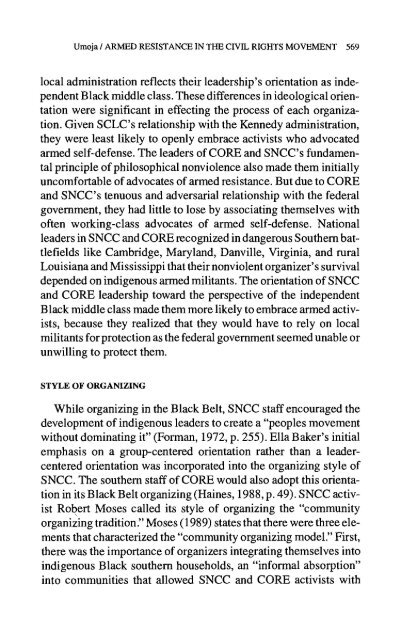MXGM Self-Defence Manual
MXGM Self-Defence Manual
MXGM Self-Defence Manual
Create successful ePaper yourself
Turn your PDF publications into a flip-book with our unique Google optimized e-Paper software.
Umoja / ARMED RESISTANCE IN THE CIVIL RIGHTS MOVEMENT 569<br />
local administration reflects their leadership's orientation as independent<br />
Black middle class. These differences in ideological orientation<br />
were significant in effecting the process of each organization.<br />
Given SCLC's relationship with the Kennedy administration,<br />
they were least likely to openly embrace activists who advocated<br />
armed self-defense. The leaders of CORE and SNCC's fundamental<br />
principle of philosophical nonviolence also made them initially<br />
uncomfortable of advocates of armed resistance. But due to CORE<br />
and SNCC's tenuous and adversarial relationship with the federal<br />
government, they had little to lose by associating themselves with<br />
often working-class advocates of armed self-defense. National<br />
leaders in SNCC and CORE recognized in dangerous Southern battlefields<br />
like Cambridge, Maryland, Danville, Virginia, and rural<br />
Louisiana and Mississippi that their nonviolent organizer's survival<br />
depended on indigenous armed militants. The orientation of SNCC<br />
and CORE leadership toward the perspective of the independent<br />
Black middle class made them more likely to embrace armed activists,<br />
because they realized that they would have to rely on local<br />
militants for protection as the federal government seemed unable or<br />
unwilling to protect them.<br />
STYLE OF ORGANIZING<br />
While organizing in the Black Belt, SNCC staff encouraged the<br />
development of indigenous leaders to create a "peoples movement<br />
without dominating it" (Forman, 1972, p. 255). Ella Baker's initial<br />
emphasis on a group-centered orientation rather than a leadercentered<br />
orientation was incorporated into the organizing style of<br />
SNCC. The southern staff of CORE would also adopt this orientation<br />
in its Black Belt organizing (Haines, 1988, p. 49). SNCC activist<br />
Robert Moses called its style of organizing the "community<br />
organizing tradition." Moses (1989) states that there were three elements<br />
that characterized the "community organizing model." First,<br />
there was the importance of organizers integrating themselves into<br />
indigenous Black southern households, an "informal absorption"<br />
into communities that allowed SNCC and CORE activists with


